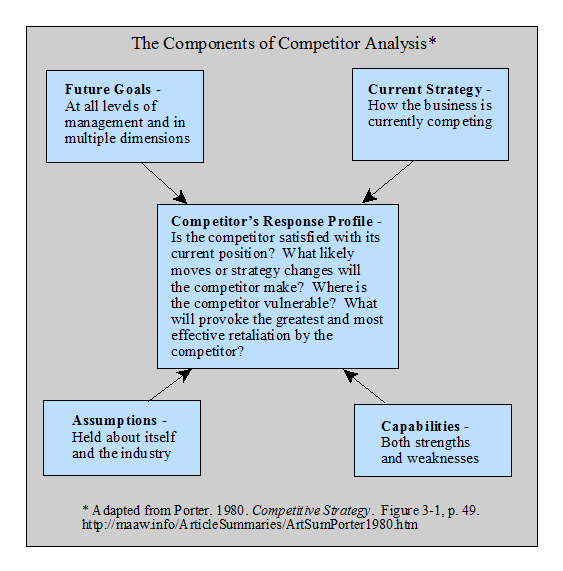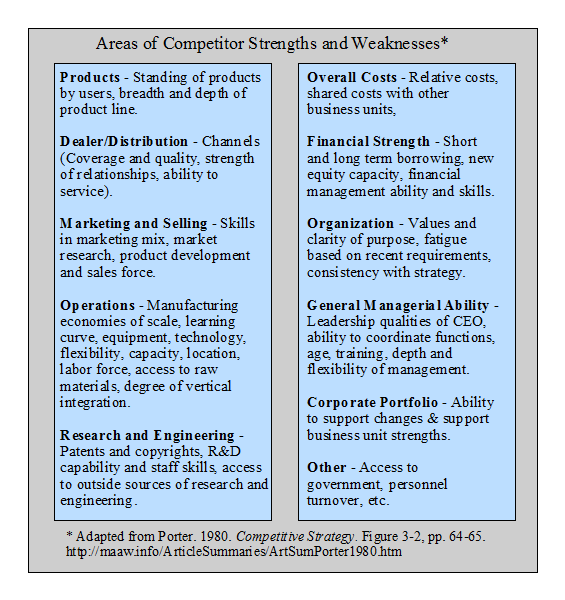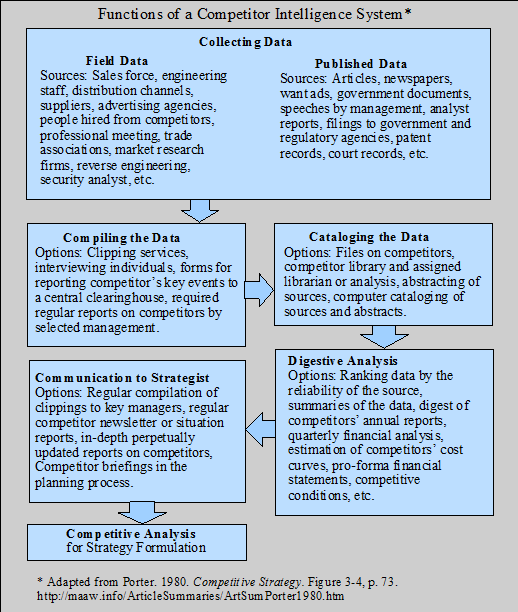
Chapter 3: A Framework for Competitor Analysis
Study Guide by James R. Martin, Ph.D., CMA
Professor Emeritus, University of South Florida
Porter's Competitive Strategy Summaries Main Page
Chapter 3: A Framework for Competitor Analysis p. 47
The purpose of this chapter is to present a basic framework for competitor analysis that includes four diagnostic components:
1. The competitor's future goals,
2. The assumptions the competitor has about itself,
3. The competitor's current strategy, and
4. The competitor's capabilities.

These four components also provide the firm with a framework for analyzing its own position in the competitive environment.
The Components of Competitor Analysis p. 49
All competitors should be analyzed including existing competitors and potential competitors. Potential competitors include: firms that could overcome entry barriers, firms with a synergy for being in the industry, firms with an obvious extension of their current strategy, and customers or suppliers that may integrate backward or forward.
Future Goals p. 50
Knowledge of competitor goals helps in predictions about the likelihood a competitor will change its strategy, how it will react to business downturns, and its reaction to strategy changes by other competitors. The firm should also analyze competitor's goals at different levels including business unit, corporate wide, and in some cases functions and key managers.
Business Unit Goals
Diagnostic questions related to determining a competitor's business unit goals include:
1. What are the competitor's financial goals, both stated and unstated?
2. What is the competitor's attitude toward risks?
3. What are the competitor's organizational values that affect its goals? For example, does it aspire to be the market or technological leader?
4. What is the competitor's organizational structure? For example, is responsibility and communication vertical (top down), or flat, i.e., horizontal and bottom up?
5. What are the competitor's control and incentive systems?
6. What type of accounting system does the competitor have, e.g., inventory valuation, cost allocation etc.?
7. What type of leadership does the competitor have? For example, what is the CEO's background and experience?
8. How much unanimity is there among managers related to goals and future direction?
9. What type of board does the competitor have, i.e., insiders, outsiders, bankers, lawyers etc.?
10. Is the competitor limited by contractual commitments?
11. How will regulatory, antitrust, or other government or social constraints influence the competitor?
Corporate Parent and Business Unit Goals p. 53
Additional diagnostic questions for situations where a business unit is part of a larger company.
1. How is the parent company doing in terms of sales growth, rate of return, and other performance measures?
2. What are the parent company's overall goals?
3. How important is the business unit to the parent's strategy?
4. Why is the parent in this business, e.g., excess capacity, to enhance marketing strength, vertical integration?
5. What is the relationship between the parent and business unit, e.g., vertically integrated, shared R&D?
6. What are the parent's top management's values and beliefs?
7. Does the parent have a generic strategy that is applied to the business unit?
8. What sort of constraints might be placed on the business unit as a result of the needs of other business units of the parent?
9. What are the diversification plans of the parent company?
10. What can be determined based on the organization structure of the parent related to the status, position and goals of the business unit?
11. How does the parent control and compensate divisional management, e.g., bonuses etc.?
12. What type of executives are rewarded by the parent?
13. Does the parent company recruit managers from within or outside the company?
14. Are there any antitrust, regulations or social problems related to the parent that might affect the business unit?
15. Does the parent have an emotional attachment to the business unit?
Portfolio Analysis and Competitive Goals p. 56
Other techniques for analyzing the parent company's portfolio include determining what criteria the company uses to classify business units, and which ones are: cash cows, candidates for harvest or disinvestment, habitual sources of stability, represent defensive moves, are the most promising for the parent, and have company leverage, i.e., have a large impact on the parent company's stability, earnings, sales growth, cash flow, or costs.
Competitor's Goals and Strategic Positioning p. 57
Analyzing a competitor's goals is important for determining how the competitor would react to strategic moves by other firms. For example, where competitive positions might be found that would not be threatening to the competitor and start a war.
Assumptions p. 58
Examining a competitor's assumptions is helpful in identifying their biases or blind spots that the company might exploit to achieve a competitive advantage. Questions useful for this purpose include:
1. What does the competitor believe about its relative competitive position in terms of cost, quality, technology, and other factors?
2. Is the competitor tied to the products based on a strong historical or emotional identification?
3. Are there cultural, regional, or national differences that influence how the competitor will react to events?
4. Are there organizational values that will influence how events will be viewed?
5. What is the competitor's belief about future demand and industry trends?
6. What does the competitor believe about the goals and capabilities of its competitors?
7. Does the competitor appear to believe in the industry conventional wisdom, e.g., common approaches, rules of thumb etc.?
8. Does the competitor view events through past and present circumstances that may not lead to objectivity?
The significance of Perceiving Blind Spots or Conventional Wisdom p. 60
Porter mentions Miller Breweries and Paramount Pictures as two examples of companies that benefited from moving on blind spots in their industries, e.g., Miller's introduction of Lite Beer and Paramount's releasing films simultaneously in a large number of theaters.
History as an Indicator of Goals and Assumptions
Questions about a competitor's history can be revealing:
1. What is the history of the competitor's financial performance in the recent past?
2. What has been the competitor's history in the industry over time?
3. What has the competitor succeeded at as a company?
4. How did the competitor react to strategic moves by other companies or industry events in the past?
Managerial Backgrounds and Advisory Relationships
The background of a competitor's leaders is another indicator of a company's goals, assumptions and probable behavior. Questions related to the leadership include:
1. What is the functional background of the competitor's top management?
2. What are the strategies that have worked for them in the past?
3. What other businesses have they worked for in the past?
4. What major events have they lived through?
5. What have they written about, or spoke about related to there business or technical background.
6. What consulting firms, advertising agencies and investment banks have they used?
Current Strategy p. 63
The third component involved in competitor analysis is to develop a statement related to each competitor's strategy. See the summary of the introduction for how to identify a strategy.
Capabilities p. 63
The final component, or diagnostic step in competitor analysis is to evaluate the competitor's strengths and weaknesses. The approach to this step involves examining the competitor's positions outlined in the illustration below.

Additional questions that make the information in Figure 3-2 more useful include questions about:
Core Capabilities - What are the competitor's capabilities in each functional area?
Ability to Grow - What is the competitor's sustainable growth potential and will the competitor's capabilities improve or diminish with growth?
Quick Response Capability - What is the competitor's capacity to respond quickly to changes by its competitors?
Ability to Adapt to Change - What is the competitor's ability to respond to competition on cost, new products, inflation, wage rate increases, etc.
Staying Power - What is the competitor's ability to sustain a competitive battle, e.g., cash reserves, lack of stock market pressure, etc.
Putting the Four Components Together - The Competitor Response Profile p. 67
Offensive and Defensive Moves
Completing an analysis of the competitor's future goals, assumptions, strategies, and capabilities leads to predicting what sort of offensive and defensive moves the competitor might make in certain situations. The likelihood the competitor will initiate strategic change based on their satisfaction with their current position, and if so what are their probable moves, and what will be the seriousness of those moves to the company. What is the competitor's defensive capability, where are they vulnerable, what would provoke them, and how effective would their retaliation be to various moves or events.
Picking the Battleground
Picking the battleground involves finding the market segment or strategy where the competitor is the weakest or the least prepared to defend.
Competitor Analysis and Industry Forecasting p. 71
After analyzing the competitor's probable moves the firm can address the implications of such moves, if the firm's are likely to clash, if the moves will invite entry by other firms, and what the implications will be for the industry.
The Need for a Competitor Intelligence System p. 71
Gathering the data needed to answer all the questions posed in this chapter is difficult and time consuming, and probably comes in trickles from many sources over a period of time. As a result, some sort of competitor intelligence system is needed to capture, compile, catalog, digest, and communicate the data to management so that it can be used in formulating strategy. The illustration below shows what a competitor intelligence system involves.

__________________________________________________
Go to the next Chapter. Porter. 1980. Competitive Strategy. Chapter 4: Market Signals. (Summary), or back to Porter's Competitive Strategy Summaries Main Page.
Other related summaries:
Christensen, C. M. 1997. Making strategy: Learning by doing. Harvard Business Review (November-December): 141-142, 144, 146, 148, 150-154, 156. (Summary).
Clinton, B. D. and A. H. Graves. 1999. Product value analysis: Strategic analysis over the entire product life cycle. Journal of Cost Management (May/June): 22-29. (Summary).
De Geus, A. 1999. The living company. Harvard Business Review (March-April): 51-59. (Summary).
Fonvielle, W. and L. P. Carr. 2001. Gaining strategic alignment: Making scorecards work. Management Accounting Quarterly (Fall): 4-14. (Summary).
Gosselin, M. 1997. The effect of strategy and organizational structure on the adoption and implementation of activity-based costing. Accounting, Organizations and Society 22(2): 105-122. (Summary).
Iansiti, M. and R. Levien. 2004. Strategy as ecology. Harvard Business Review (March): 68-78. (Summary).
Kaplan, R. S. and D. P. Norton. 1996. Using the balanced scorecard as a strategic management system. Harvard Business Review (January-February): 75-85. (Summary).
Kaplan, R. S. and D. P. Norton. 2000. Having trouble with your strategy? Then map it. Harvard Business Review (September-October): 167-176. (Summary).
Kaplan, R. S. and D. P. Norton. 2001. Transforming the balanced scorecard from performance measurement to strategic management: Part I. Accounting Horizons (March): 87-104. (Summary).
Kaplan, R. S. and D. P. Norton. 2001. Transforming the balanced scorecard from performance measurement to strategic management: Part II. Accounting Horizons (June): 147-160. (Summary).
Kaplan, R. S. and D. P. Norton. 2004. Measuring the strategic readiness of intangible assets. Harvard Business Review (February): 52-63. (Summary).
Kim, W. C. and R. Mauborgne. 1997. Value innovation: The strategic logic of high growth. Harvard Business Review (January-February): 103-112. (Summary).
Kim, W. C. and R. Mauborgne. 1999. Creating new market space: A systematic approach to value innovation can help companies break free from the competitive pack. Harvard Business Review (January-February): 83-93. (Summary).
Kim, W. C. and R. Mauborgne. 2002. Charting your company's future. Harvard Business Review (June): 77-83. (Summary).
Langfield-Smith, K. 1997. Management control systems and strategy: A critical review. Accounting, Organizations and Society 22(2): 207-232. (Summary).
Luehrman, T. A. 1998. Strategy as a portfolio of real options. Harvard Business Review (September-October): 89-99. (Summary).
Malone, D. and M. Mouritsen. 2014. Change management: Risk, transition, and strategy. Cost Management (May/June): 6-13. (Summary).
Martin, J. R. Not dated. What is a learning curve? Management And Accounting Web. LearningCurveSummary.htm
O'Clock, P. and K. Devine. 2003. The role of strategy and culture in the performance evaluation of international strategic business units. Management Accounting Quarterly (Winter): 18-26. (Summary).
O'Reilly, C. A. III. and M. L. Tushman. 2004. The ambidextrous organization. Harvard Business Review (April): 74-81. (Summary).
Porter, M. E. 1996. What is a strategy? Harvard Business Review (November-December): 61-78. (Summary).
Porter, M. E. 2001. Strategy and the internet. Harvard Business Review (March): 63-78. (Summary).
Reeves, M., C. Love and P. Tillmanns. 2012. Your strategy needs a strategy. Harvard Business Review (September): 76-83. (Note).
Shenkir, W. G. and P. L. Walker. 2006. Enterprise risk management and the strategy-risk-focused organization. Cost Management (May/June): 32-38. (Summary).
Simons, R. 1995. Control in an age of empowerment. Harvard Business Review (March-April): 80-88. (Summary).